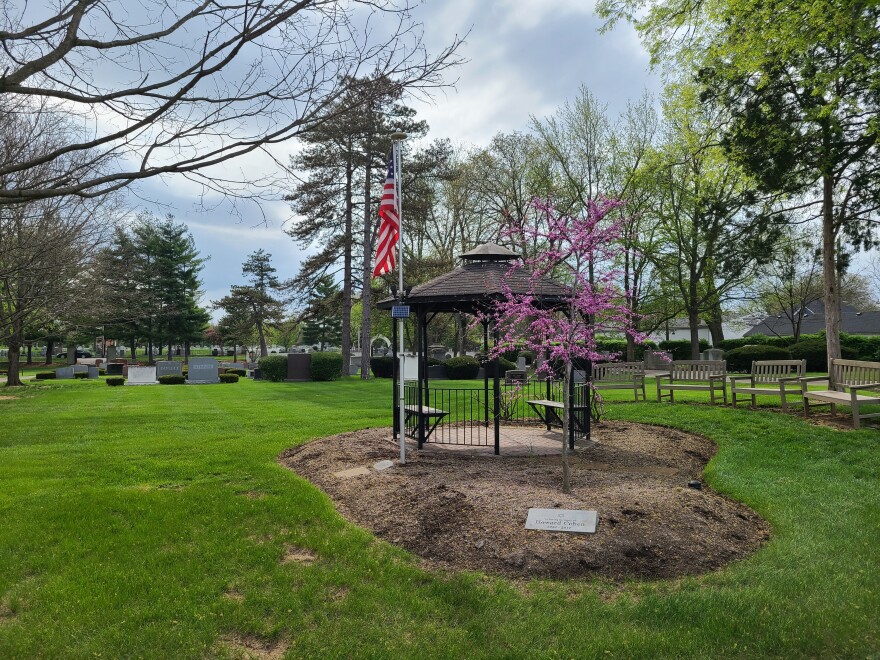All this year Cincinnati's Jewish population is celebrating 200 years of communal life. As part of our community storytelling project Round the Corner, WVXU's Tana Weingartner takes us to a pair of Jewish cemeteries in Hamilton's historic Lindenwald neighborhood.
On the very southern edge of Lindenwald, in what would've been considered really far outside the city of Hamilton 160 years ago, you'll find a pair of cemeteries. To the east, St. Mary's, dating to 1867. The final resting place of Hamilton's early Irish Catholics and still used by many parishes today. Across the street to the west, through a pair of miss-matched archways, sits a Jewish cemetery.
Actually, it's two cemeteries side-by-side: Bene Israel and Beth Israel.
Carrie Rhodus is operations manager for Jewish Cemeteries of Greater Cincinnati, which is in charge of Bene Israel. She points to a pair of pine trees in the middle of gray headstones.
"This is our cemetery," she says, indicating the older section to the south. "The dividing line used to be this row of tall pine trees and, unfortunately, there's only two of them left. Now you just sort of have to imagine where the dividing line is."
A fence separated the properties at one time but that felt inappropriate and the pine trees were planted instead.

Rhodus explains much like Joseph Jonas — the first Jewish settler in Cincinnati — a man named Jacob Grabenheimer was the first Jew in Butler County. He, too, was alone for about 10 years until there were enough people — mainly German-Jewish immigrants — to form a congregation.
"On July 29, 1866, they founded their congregation, and they practiced in rented rooms above a local dry goods store that was owned by one of the members of the congregation. The first thing that the congregation did once they could afford to do so was establish this cemetery in October of 1870," Rhodus says.
In 1873, two of Bene Israel's founders attended a conference in Cincinnati called by Rabbi Isaac Mayer Wise. It led to the establishment of the Union of American Hebrew Congregations, and ultimately the distinction of Cincinnati becoming the birthplace of Reform Judaism in North America.
A hundred years after its founding, the congregation merged with Wise Temple in Cincinnati. The cemetery remains active, though Rhodus says it has only about one to three burials per year.
Some three decades later in 1901 — seven years before Lindenwald was officially annexed into the city of Hamilton — another Jewish congregation sprang up. It was called Beth Israel Synagogue. These first families were Yiddish-speaking immigrants and more traditional, preferring Orthodox Judaism.
In those early years, Beth Israel's members had to travel to Western Hills to bury their loved ones because the local Reform cemetery — that's Bene Israel — didn't adhere to some of the traditional Jewish burial rules.
"Then, in the '50s, they decided that they wanted to have a cemetery here and they were able to acquire the lot next to the Reformed congregations cemetery. (They) bought the land and it's been used by the Jewish community of Hamilton ever since," explains Rabbi Eric Slayton, rabbi of Beth Israel Synagogue in Hamilton.

Slaton describes Beth Israel as a small congregation, drawing members from around Butler and Warren counties. The synagogue transitioned from Orthodox to Conservative in the '80s and has about 80 to 100 families.
They take pride, Slaton says, in preserving the cemetery. There's a gazebo for people to sit and meditate, and special services for certain occasions like the High Holy Days. The congregation and Jewish Cemeteries of Greater Cincinnati cooperate on maintenance and grounds keeping, but Beth Israel maintains its independence.
Slaton says they have acquiesced to modernity in one way. He points to a section of the cemetery beyond a row of bushes.

"In a traditional Jewish congregation, you're not allowed to bury someone who's not Jewish," he says. "That wasn't a problem for most of Jewish history because you just didn't have Jews and Christians marrying each other, or Jews and Muslims or whatever. So what we've done is we've created a dedicated section for people who who are not Jewish, so they can still be buried in our cemetery, and still be with their loved ones."
Nationally, 44% of Jews have a non-Jewish spouse. In Greater Cincinnati, it's 55%.
"People who are buried here originally expected to be buried in a cemetery that was just of Jewish people and we have to honor that. But we also have to honor the fact that our community is changing," Slaton says.

In Jewish cemeteries it's customary to leave a stone on a loved one's grave. Looking around you'll see these small rocks on many headstones in both of the cemeteries. Most are small and plain, a few are painted with scenes of trees or flowers. It's a symbolic gesture — a way of saying "I remember you."
On a personal note, I've placed a stone here, too. Don Leshner, the Golden Tones of WMUB, and one of the station's founders when it signed on as Greater Cincinnati's first public radio station, is buried here in the Bene Israel cemetery. Leshner was my office mate when I first started working at WMUB.
A World War II Purple Heart veteran and Bronze Star recipient, he was a kind man with a big voice made for radio.




